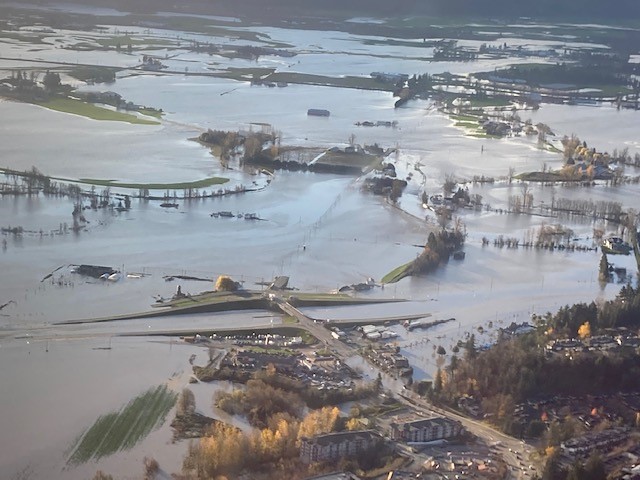
This joint op-ed was originally published in the Globe & Mail on April 14, 2022. The authors are members of the Lower Fraser River Working Group, a collaborative research group that represents the voices of Indigenous community leaders and fishers, scientists and lawyers.
Flood recovery efforts in B.C. are under way and will cost many billions of dollars before they are complete. The latest estimate from the Globe and Mail projects a cost of almost $9 billion. However, we need to reflect more deeply on how we should be moving forward—is our recovery plan sustainable and does it move us closer to righting historic wrongs as well as adapting to the impacts of climate change?
As flood recovery investment decisions are being made for the Sumas region (the Semá:th lake-bed) and neighbouring areas, we question what type of recovery makes sense with this historical context, in a time of rapid climate change? The cost of recovery in the Sumas region already sits at $450 million and this does not include the loss of uninsured land and infrastructure nor the cost of upgrades to the dikes and pump stations that keep Semá:th Lake from returning.
The historic wrongs brought about through decision-making that led to the taking of this lake from the Semá:th people, coupled with the challenging losses and disruptions experienced by those living in the area today as a result of the floods, call for deeper reflection for how to move forward.
Our analysis reveals the cost of maintaining the Sumas region as a prairie will exceed $4.5 billion. While this estimate includes the updates required for the Sumas and Matsqui dikes, it does not account for future damages and class-action lawsuits, or consider climate projections predicted for 2050 and beyond.
Instead of maintaining Sumas Prairie in its current state, we are proposing a form of restoration of Semá:th Lake. This option is called “managed retreat”, a purposeful movement of people, buildings, etc., from areas vulnerable to hazards. This is a powerful tool being used around the world in areas prone to repeat flooding as a result of climate change. Our analysis estimates the cost of this option to be around $3 billion, with $1 billion for the purchase of land and buildings at current assessed values, with the remainder for cleanup, removal and modification of current diking and pump station infrastructure.
Our work with Indigenous knowledge holders and fishers of the Lower Fraser has shown us that the response to crises over millennia by the ancestors of this land has been guided by instruction from people with necessary expertise. Great floods have happened in the Lower Fraser historically as shown in the sxwōxwiyám / sx̌ʷəx̌ʷəyém ‘stories of the distant past’ or ‘tell stories’. The way in which these floods were overcome were through hard lessons and collaboratively working together: S’iwes Toti:lt Q’ep / syə́θəstəl̕ ʔəy səlí̕q̓ tátələ̕t ‘teaching and learning together’.
There are stories that describe how ecological conditions were established by ancestors and other beings, such as Xe’xá:ls / x̌eʔx̌é∙l̕s ‘transformers who made the world right’ and these conditions were maintained in abundance by Indigenous stewardship throughout time. When these stewardship responsibilities are not followed, impacts to the land, water, animals and people can be detrimental, as we are seeing now.
Today, when jurisdiction is not respected and Indigenous knowledge is excluded from land use decisions, negative consequences flow to various relationships and aspects of life. The draining of Sema:th Lake and the conversion of rich lakebed soils into farmland is one example that continues to have negative consequences to all aspects of life. Moving forward and adapting to climate change will require engaging Indigenous knowledge transfer and learning by doing.
Restoring Semá:th Lake would require planning together, righting past wrongs, and learning from the natural laws of Semá:th Lake and its people. Central to this process will be S’iwes Toti:lt Q’ep / syə́θəstəl̕ ʔəy səlí̕q̓ tátələ̕t ‘teaching and learning together’. Collaboratively, Indigenous Nations, local governments, as well as provincial and federal decision-makers can draw upon the myriad of tools already in place, including the United Nations Declaration on the Rights of Indigenous Peoples (UNDRIP), BC’s DRIPA and a Memorandum of Understanding (MOU) between Sumas First Nation, the Province and the City of Abbotsford to guide this path forward.
We call on all governments to pause and reflect on an alternative path for the Sumas region, one that acknowledges the ongoing threat posed by climate change induced flooding, the cost and risk of planning ‘business as usual’ and the need for innovative, informed and inspired regional planning to support climate adaptation and reconciliation.
Authors:
- Rayanna Seymour-Hourie – West Coast Staff Lawyer & RELAW Program Manager
- Deborah Carlson – West Coast Staff Lawyer
- Murray Ned – Executive Director, Lower Fraser Fisheries Alliance
- Leah Ballantyne – RELAW Coordinator, Lower Fraser Fisheries Alliance
- Dr. Tara Martin – Martin Conservation Decisions Lab, UBC
- Kristen Walters – Raincoast Conservation Foundation
- Janice Kwo – Lower Fraser Fisheries Alliance
- Ian Hamilton – Lower Fraser Fisheries Alliance
- Riley Finn – Martin Conservation Decisions Lab, UBC
The Lower Fraser River Working Group is a collaborative research group that represents the voices of Indigenous community leaders and fishers, scientists and lawyers. Our analysis is guided by an understanding of geographical, social and legal landscapes, combined with two-eyed seeing–bridging Indigenous knowledge and law with western science and Canadian law. For more information, please visit https://www.lffa.ca/initiatives/relaw
Photo credit: BC Ministry of Transportation via Flickr Creative Commons